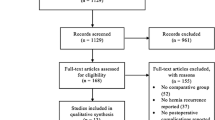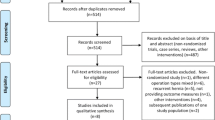Abstract
Background: The choice of approach to the laparoscopic repair of inguinal hernia is controversial. There is a scarcity of data comparing the laparoscopic transabdominal preperitoneal (TAPP) approach with the laparoscopic totally extraperitoneal (TEP) approach, and questions remain about their relative merits and risks.
Methods: Electronic databases were searched to identify reports of trials comparing laparoscopic TAPP with laparoscopic TEP. In addition, selected conference proceedings were hand-searched, websites consulted, reference lists of all included papers were scanned, and experts contacted for other potentially eligible reports. All published and unpublished randomised controlled trials and quasi-randomised controlled trials comparing laparoscopic TAPP with laparoscopic TEP for inguinal hernia repair were eligible for inclusion. Large non-randomised prospective studies were also eligible for inclusion to provide further comparative evidence of complications and serious adverse events. Two reviewers independently extracted data and assessed study quality. Statistical analyses were performed using the fixed effects model and the results expressed as relative risk (RR) for dichotomous outcomes and weighted mean difference (WMD) for continuous outcomes with 95% confidence intervals (CI).
Results: The search identified one RCT which reported no statistically significant difference between TAPP and TEP when considering duration of operation, haematoma, length of stay, time to return to usual activities, and recurrence. The eight non-randomised studies suggest that TAPP is associated with higher rates of port-site hernias and visceral injuries whilst there appear to be more conversions with TEP. Vascular injuries and deep/mesh infections were rare and there was no obvious difference between the groups. No studies reporting economic evidence were identified.
Conclusions: There is insufficient data to allow conclusions to be drawn about the relative effectiveness of TEP compared with TAPP. Efforts should be made to start and complete adequately-powered randomised controlled trials (RCTs), which compare the different methods of laparoscopic repair.
Similar content being viewed by others
References
Ferzli G, Masaad A, Albert P et al. (1993) Endoscopic extraperitoneal herniorrhaphy versus conventional hernia repair. A comparative study. Curr Surg 50:291–294
Wright D, O’Dwyer PJ (1998) The learning curve for laparoscopic hernia repair. Semin Laparosc Surg 5:227–232
McCormack K, Wake B, Perez J et al. (2004) Systematic review of the clinical effectiveness and cost-effectiveness of laparoscopic surgery for inguinal hernia repair. Health Technol Assess (in press)
Drummond M, O’Brien B, Stoddart G, Torrance G (1997) Methods for the economic evaluation of healthcare programmes, 2nd edn. Oxford University Press, Oxford
Yusuf S, Peto R, Lewis J et al. (1985) Beta blockade during and after myocardial infarction: an overview of randomized controlled trials. Prog Cardiovasc Dis XXVII:335–371
Schrenk P, Woisetschlager R, Rieger R et al. (1996) Prospective randomised trial comparing postoperative pain and return to physical activity after transabdominal preperitoneal, total preperitoneal or Shouldice technique for inguinal hernia repair. Brit J Surg 83:1563–1566
Cohen RV, Alvarez G, Roll S et al. (1998) Transabdominal or totally extraperitoneal laparoscopic hernia repair? Surg Laparosc Endosc 8:264–268
Felix EL, Michas CA, Gonzalez MH Jr (1995) Laparoscopic hernioplasty. TAPP vs TEP. Surg Endosc 9:984–989
Khoury N (1995) A comparative study of laparoscopic extraperitoneal and transabdominal preperitoneal herniorrhaphy. J Laparoendosc Surg 5:349–355
Lepere M, Benchetrit S, Debaert M et al. (2000) A multicentric comparison of transabdominal versus totally extraperitoneal laparoscopic hernia repair using PARIETEX meshes. J Soc Laparoendosc Surg 4:147–153
Van Hee R, Goverde P, Hendrickx L et al. (1998) Laparoscopic transperitoneal versus extraperitoneal inguinal hernia repair: a prospective clinical trial. Acta Chir Belg 98:132–135
Weiser HF, Klinge B (2000) Endoscopic hernia repair—Experiences and characteristic features. Viszeralchirurgie 35:316–320
Tamme C, Scheidbach H, Hampe C et al. (2003) Totally extraperitoneal endsocopic inguinal hernia repair (TEP). Surg Endosc 17:190–195
Baca I, Schultz C, Gotzen V et al. (2000) Laparoscopic inguinal hernia repair. A review of 2500 cases. In: Lomanto D, Kum CK, So JBY, Goh PMY (eds) Proceedings of the 7th World Congress of Endoscopic Surgery, Singapore, 1–4 June 2000. Monduzzi Editore, Bologna, Italy, pp 425–430
Leibl BJ, Schmedt CG, Kraft K et al. (2000) Laparoscopic transperitoneal hernioplasty (TAPP)—efficiency and dangers. Chir Gastroenterol 16:106–109
The EU Hernia Trialists Collaboration (2002) Laparoscopic versus open groin hernia repair: meta-analysis of randomised trials based on individual patient data. Hernia 6:2–10
The EU Hernia Trialists Collaboration (2002) Open mesh versus non-mesh repair of groin hernia: meta-analysis of randomised trials based on individual patient data. Hernia 6:130–136
McCormack K, Scott NW, Go PMNYH et al. (2003) Laparoscopic techniques versus open techniques for inguinal hernia repair. In: The Cochrane Collaboration (2003) The Cochrane Library, Issue 1. Update Software, Oxford
Acknowledgements
This systematic review was funded by the UK Department of Health and administered by the NHS Executive R&D Health Technology Assessment Programme as a Technology Assessment Review conducted for the National Institute for Clinical Excellence. The Health Services Research Unit and Health Economics Research Unit are funded by the Chief Scientist’s Office of the Scottish Executive Health Department. The views expressed are those of the authors and may not be those of the funding bodies. A more detailed version of this review will be published and updated in the Cochrane Database of Systematic Reviews.
Author information
Authors and Affiliations
Corresponding author
Rights and permissions
About this article
Cite this article
McCormack, K., Wake, B.L., Fraser, C. et al. Transabdominal pre-peritoneal (TAPP) versus totally extraperitoneal (TEP) laparoscopic techniques for inguinal hernia repair: a systematic review. Hernia 9, 109–114 (2005). https://doi.org/10.1007/s10029-004-0309-3
Received:
Accepted:
Published:
Issue Date:
DOI: https://doi.org/10.1007/s10029-004-0309-3




